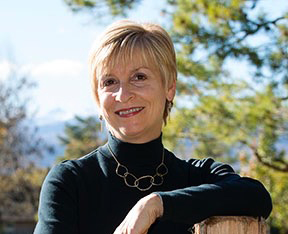Designing for Equity
A Force (for Student Success) to Be Reckoned With
Topics
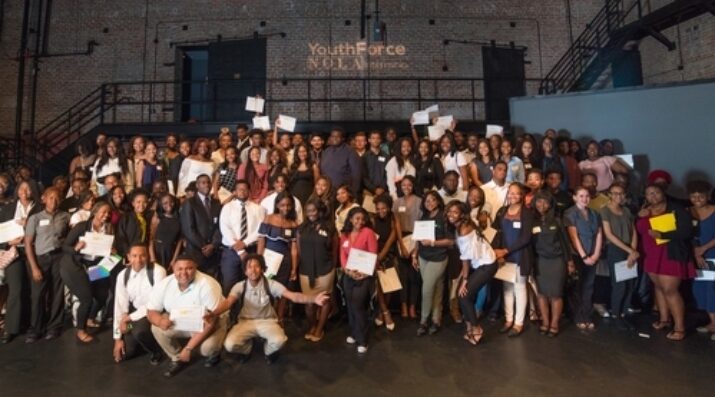
Together, educators are doing the reimagining and reinvention work necessary to make true educational equity possible. Student-centered learning advances equity when it values social and emotional growth alongside academic achievement, takes a cultural lens on strengths and competencies, and equips students with the power and skills to address injustice in their schools and communities.
Practitioner's Guide to Next Gen Learning
Students from low-income households and students of color are often less prepared to succeed in today's competitive marketplace for careers than their white, affluent counterparts. YouthForce NOLA is working to change that.
I am a first generation American on my father’s side. I believe in the promise of the United States as a place of opportunity, and in education as the way to achieve the American Dream. Traditional K–12 is not delivering on that promise for far too many of our kids.
—Cate Swinburn, president of YouthForce NOLA
Many of us associate the American Dream with social mobility, with children achieving greater success than their parents did. For centuries, education helped make that dream a reality, at least for some. However, today’s young people are confronted with a work/learn landscape that is substantially different from that of the past.
As documented in the NGLC MyWays Student Success Series, employers are seeking candidates with a range of skills and knowledge much broader than academic content alone—competencies like problem solving, collaboration, communication, and goal setting. They are also making work experience a priority in hiring. As YouthForce NOLA’s Cate Swinburn puts it, “Employers don’t want their position to be anyone’s first job.”
Moreover, graduates are entering a society that is increasingly polarized with respect to employability in high-wage, high-skill careers. As a result of unequal access to opportunity and outmoded learning models, students from low-income households and students of color are often less prepared to succeed in this competitive marketplace than their white, affluent counterparts.
Many innovative schools and organizations, however, are working together to design learning experiences that prime all students for success in their adult lives. For this edition of Friday Focus: Practitioner’s Guide to Next Gen Learning, I spoke to Cate Swinburn, president of YouthForce NOLA. The nonprofit, an education, business, and civic collaborative in New Orleans, is dedicated to building the capacity of K–12 schools, employers, and training providers, so that students graduate ready for postsecondary success. The organization is also a participant in the Transforming Learning Collaborative (TLC), a partnership founded by NGLC, Da Vinci Schools, and Schools That Can. Cate described YouthForce NOLA’s work including:
- YouthForce NOLA’s mission and origin story
- How the organization supports students, educators, employers, training providers, and the community
- The results they’ve achieved and their plans for the future
From Conversations to Commitment
Our collaborative effort to build YouthForce NOLA was not about launching a nonprofit—it was about collective impact and action.
—Cate Swinburn
According to a survey from the Cowen Institute at Tulane University about youth in New Orleans, 16 percent of 16–24 year-olds are disconnected from both employment and the educational system. Looking at the data another way: these young people—often called opportunity youth—outnumber high school graduates three to one. Opportunity youth, 87 percent of whom are black, face significant barriers to achieving success.
At the same time, according to YouthForce NOLA, the greater New Orleans region is expecting 70,000 high-wage, high-demand jobs to become available over the next ten years. Yet many young people do not have the skills or connections to obtain them.
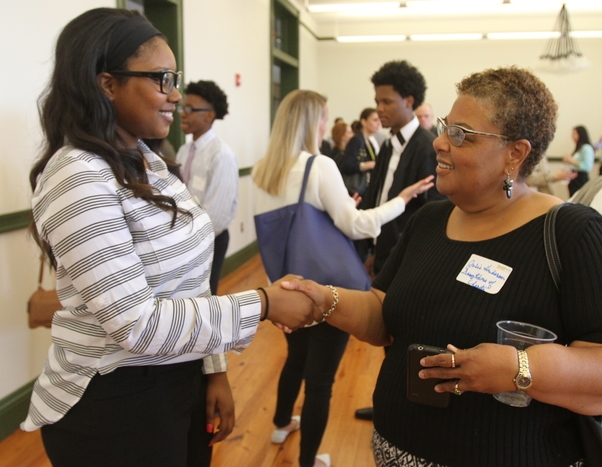
As part of YouthForce NOLA’s internship program, students interact with employers at a meet-and-greet event.
Cate’s engagement with New Orleans began in 2012, when she moved to the area and started her own education consulting business, focusing on systems approaches to addressing inequities and building coalitions for student success. As the 10-year anniversary of Hurricane Katrina approached, she observed a great deal of community energy and interest in opportunity youth and workforce development. Cate describes the mood of that time: “The state was authorizing a new diploma policy, and we had new data about opportunity youth. There were calls to action on workforce development because talent was a huge issue. People were asking questions like, ‘Is New Orleans better than before the levees broke?’ and having lots of conversations on what we needed to do.”
YouthForce NOLA, originally an initiative of Educate Now!, one of Cate’s consulting clients, was born out of an effort to “weave all of these conversations together and develop a system-wide plan.” YouthForce NOLA’s strategy was collaborative from the outset, Cate explains, and she tells the story of a field trip that shaped their vision. Cate knew from her time as a district leader in Washington, D.C., that the nation’s capital was ahead of New Orleans in high school career pathways programming. She therefore organized a 26-hour whirlwind trip to D.C. for the 18 civic, education, and business leaders who later became the new initiative’s steering committee. After meeting with employers and education leaders there, Cate recalls, this group of 18 “pinky swore” to collaborate and build YouthForce NOLA.
Today, the organization is still a collaborative effort. The steering committee includes twelve members representing a wide spectrum of local civic, business, and education leaders. YouthForce NOLA, in partnership with more than 100 employers, currently works with 84 percent of Orleans Parish’s open enrollment high schools. The organization offers expanded coursework, career exposure and experiences, employer-validated credentials, as well as training and practice in the essential competencies for workplace success—what many employers call the soft skills and what NGLC refers to as Habits of Success and Creative Know How.
YouthForce NOLA’s aspirations for students are ambitious. By integrating career education into the K–12 experience, they aim not just to prepare students for employment, but also to increase their engagement in learning, the likelihood of postsecondary success, and ultimately life-long success. For that reason, according to Cate, YouthForce NOLA focuses on preparing secondary students for high-skill careers that pay above the regional median. As she puts it, “Wouldn’t it be transformational if every 25-year-old were making $33K or more?”
From Collaboration to Collective Action
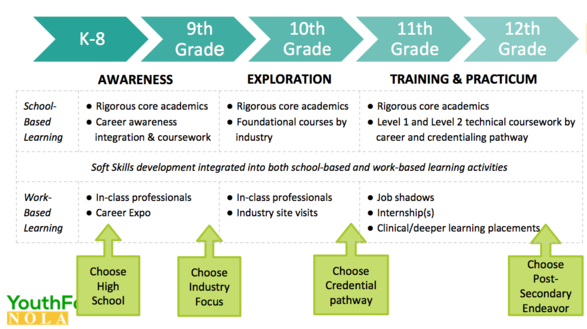
YouthForce NOLA’s vision for student success includes both academic preparation and real-world skills and opportunities.
Cate broadly describes YouthForce NOLA’s approach as one of figuring out “what is needed for a career and then mapping back to K–12, prioritizing what is missing from the education ecosystem: soft skills, career exposure, and work experience.” According to Cate, YouthForce NOLA believes in learning by doing and that workforce skills are best learned on the job, so “let’s help students get their first job while in high school.”
What that looks like for students is a multi-year journey that runs parallel to school-based academic learning. Following a trajectory from awareness of career options to exploration of potential industries to training and practicum experiences, learners chart a pathway and gradually home in on a postsecondary endeavor. Unlike many seniors, however, these graduates make a choice based on deep knowledge of the career landscape. Their pathway is also accompanied by the coursework, ongoing workplace skill development, industry-recognized credentials, and work experiences, such as paid internships, that will set them up to thrive in their chosen field.
YouthForce NOLA also supports collaborating schools and educators. The organization offers soft skills teacher fellowships, industry externships, and a community of practice. Schools that partner with YouthForce NOLA also receive one-on-one coaching support and may qualify for $50,000 grants to advance their career pathway programs.
Equity is always at the forefront of YouthForce NOLA’s priorities and planning. Eighty-five percent of students in partner schools qualify as economically disadvantaged, and 95 percent are students of color. “In a land of limited resources,” Cate explains, “we want to bring our resources to those who have been historically excluded, prioritizing the students the status quo would not include.”
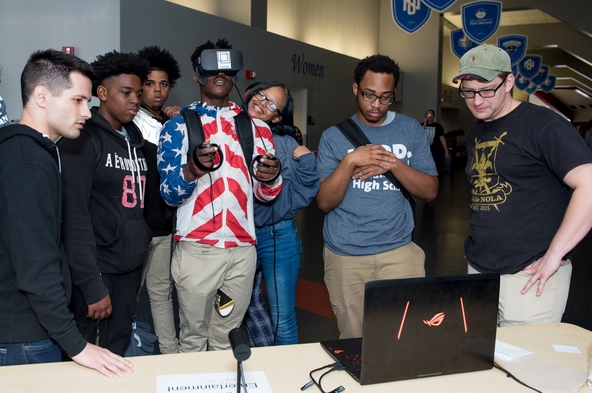
High school students from New Orleans learn about real-world skills and opportunities at YouthForce NOLA’s Career Expo focused on high-priority employment sectors.
From Present to Future Success
YouthForce NOLA’s five-year strategic plan includes three major goals for the class of 2020: 20 percent of students earning advanced, industry-recognized credentials; ten percent completing YouthForce work-based, paid internships; and across-the-board development of employer-validated, career-ready skills. “We are on track to meet our goals and seeing lots of success,” Cate reports.
In New Orleans Parish schools, for example, she notes that conversations about postsecondary readiness now include more than academic preparedness. Although measuring non-academic skills presents a challenge, integrating these soft skills throughout school-based and workplace learning is gaining momentum among partner schools.
YouthForce NOLA’s Career Expo program, one of their signature events for career awareness, has connected 2,200 students from 19 schools to 75 employer and training exhibitors. In addition, the organization’s efforts were instrumental in obtaining approval for a new set of advanced credentials in priority sectors, including AutoDesk Inventor, Emergency Medical Technician, and Adobe Visual Design Specialist.
Not one for resting on YouthForce NOLA’s laurels, however, Cate looks forward to working with and learning from Kim Merritt, director of Da Vinci Extension (DVX), a postsecondary college bridge program in El Segundo, California. Kim is YouthForce NOLA’s mentor in the TLC Incubator.
“We aim to help more schools do it better and faster,” Cate explains, “but what if what we have in our scope of work is not enough to achieve our vision for students? The TLC Incubator allows us to learn from Kim’s experiences with postsecondary bridges. For example, is there a way we could develop a 13th year program that would allow more students to access the skill-building they need while they are still safely in the in-school youth category? As part of the TLC, we can study Da Vinci’s model and bring back lessons for New Orleans.”
Resources
- “An Innovative Approach to Preparing Students for College and Careers,” released by the nonprofit education and social policy organization MDRC, highlights YouthForce NOLA as an example of a promising career pathways initiative designed to prepare New Orleans public high school students for postsecondary education opportunities and careers.
- This news story and video features a recent Career Expo event, a joint effort between YouthForce NOLA and partner Junior Achievement.
- A NOLA.com story about the Cowen Institute at Tulane University’s report on opportunity youth in New Orleans summarizes the study’s key findings and provides a link to the full report.
- “New Orleans Business Case for Racial Equity,” a report by the W.K. Kellogg Foundation, makes a compelling economic argument for the social justice imperative of racial equity.
- “Preparing Apprentice-Adults for Life After High School,” Report 5 of the NGLC MyWays Student Success Series, examines the adolescent developmental tasks that are key to a healthy life and to successfully navigating the work/learn landscape.

